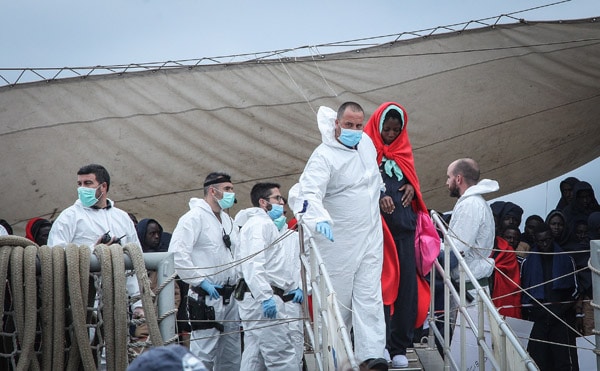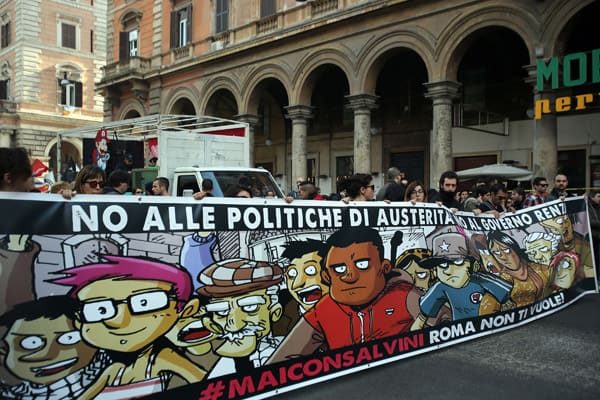Italy and the “Refugees”
John Bruce Leonard, American Renaissance, March 31, 2017
I am an American who for five years has lived in Sardinia, a quiet and remote part of Italy that is relatively unaffected by the recent immigration crisis. Nevertheless, the changes I have seen even in this short period are striking.
The flood upon us
Together with Greece, Italy is the main port of entry for the great majority of refugees to Europe. By official count, in 2016 Italy received some 180,000 asylum-seekers, the better part of them from Africa. The numbers are up from 2014 and 2015, which brought roughly 170,000 and 150,000, respectively. This is half a million immigrants in the course of three years, an influx of unprecedented magnitude.
The number of arrivals is known with some precision; after that, things get muddy. Of the 170,000 who came in 2014, for example, only 65,000 officially requested asylum, which was granted to about 40,000. These 40,000 were issued temporary visas and were free to move throughout the Schengen Area. The 25,000 who were denied asylum — a mere 15 percent of the total 2014 arrivals — were ordered to leave. No one knows how many actually left.
What about the 105,000 who arrived in 2014 but didn’t apply for asylum? It would seem that no one — not the Prime Minister in Rome nor the local officials who must accommodate incoming refugees — has the faintest idea. They are probably somewhere in Europe.

Refugees camp in front of the Rome’s Tiburtina station on June 15, 2015. (Credit Image: © Danilo Balducci/UPPA/ZUMA Wire)
I have just cited official figures. Italy has 4,500 miles of coast, and it is difficult to imagine that there has not been leakage. Also, only the blindly optimistic could suppose that the Mafia is not profiting from the chaos in Africa and the incompetence in Europe as boatloads of refugees debark on Italian shores.
Confcommercio, the general confederation of Italian businesses, which does statistical analysis of many aspects of Italian life, used government crime data in a useful report on immigration and crime in 2016. Its conclusion: “These calculations lead us to conclude that, approximately and on average, crime rates for Italians, legal aliens, and illegal aliens are . . . equal respectively to 4.3, 8.5, and 246.3 per 1,000 individuals of the group in question.” (Translation mine.)
This means legal aliens are twice as likely as Italians to commit crimes and illegal aliens are 57 times as likely. With regard to specific crimes, legal aliens are twice as likely as Italians to commit armed robbery, 2.5 times as likely to be arrested for drug offenses, three times as likely to commit rape and burglary, and nine times as likely to be involved in prostitution. Illegal aliens are 38 times as likely as Italians to commit homicide or acts of injurious violence, 48 times more likely to rape, 52 times as likely to be involved in drug-related crimes, 67 times as likely to perpetrate armed robbery, 102 times as likely to commit burglary, and 120 times as likely to be involved in prostitution.
Some have argued that the very high crime rates for illegal immigrants are due at least in part to their illegal status. It would be useful to compare the crime rates of legal and illegal aliens from Africa or the Middle East, but we do not have the data. We know only that illegal aliens are predominately African or Middle Eastern while legal aliens are not. It is hard to imagine that granting temporary visas to rejected “refugees” would greatly reduce their crime rates.
The new face of Italy
I live near Cagliari, the capital city of Sardinia. The immigrants to this island in 2016 were just five percent of the nationwide total, or about 9,000 people. There have been enough to leave a visible mark.
When I first arrived in 2013, just before the immigrant tidal waves, the few Africans and Middle Easterners were quaint rarities. They seldom married into Italian families, but they were commonly known by name in their communities. It was universally understood that they sent the better part of their meager earnings to family members in foreign countries, and that they lived in crowded apartments in wretched and illegal conditions. But the Italians are magnanimous, and all of this was tolerated so long as these foreigners behaved — which, by and large, they did.
The more recent immigrants are different. One hardly ever sees them interacting with Italians, except when they are begging or peddling bric-a-brac. Though some have lived here for several years, they rarely speak anything but the most rudimentary Italian. They hold out their hats out on street corners, sell knick-knacks at stoplights, or — a favorite practice — act as unofficial parking guides. They gather wherever there is public parking, to indicate open spaces to incoming cars. They then ask to be paid for this totally officious service, only to become indignant when they are refused. Indeed, I myself have seen them grow more brazen year by year; lately they will pursue those who do not pay, aggressively demanding money.
And even on our remote island, some of them commit serious crimes. A Nigerian woman attacked the head of a local refugee center with a kitchen knife. An incarcerated immigrant threw feces at his prison guard before attacking and wounding him. An African prisoner punched and bit a prison guard. A Nigerian man threatened and shouted at a female police officer who tried to stop him from strewing trash onto the street from bags he had extracted from a dumpster.
A Moroccan at the Cagliari marina decided to sunbathe nude on a public bench. Another immigrant showed his genitals to passing families on a sidewalk. A Pakistani had to be arrested when he began masturbating in a park in front of women and children. An immigrant from the Ivory Coast fell to arguing with his wife in front of a bar. He ended the dispute by beating her, biting her on the arm, and running her over with a car. At the Cagliari city hall, a group of irate immigrants falsely claimed to have an appointment with the mayor; when they were denied entry, they tried to force their way in.
A family of blacks tried to board a bus without tickets, only to be told by the driver that in Italy everyone buys a ticket before boarding. The man became furious and began to scream at the driver. A young Italian woman explained that in such a situation one gets off the bus. The black man walked half the length of the vehicle to slap and hit her repeatedly in the face.
Such events have grown so frequent that the police of Cagliari recently protested in front of their own headquarters for a stop to immigration.
Ninety percent of refugees are men, which helps explain why one sees so few women. But a portion of them are elsewhere: prostitution has flourished under their watch. Though the Africans have no monopoly on this business, they are visibly overrepresented. One sees them at all hours of the day or night, dressed provocatively, warming themselves over trash fires. There are stretches along streets where large groups of them gather on lawn chairs, in a surreal landscape of charred refuse and shattered furniture.
These are not red-light districts; just peripheral parts of the city in which there are too few Italian residences to warrant adequate police controls. The women have shown up in just the last five years. Like their parking-lot counterparts, they set up shop beside respectable businesses, and use the restrooms of public institutions such as hospitals, leaving behind them signs of a different sense of hygiene.
Diseases that were thought eradicated have returned. There has been a rash of meningitis which claimed six victims in Tuscany in 2016 alone; the strain appears to have been imported from the south. Syphilis is back, thanks no doubt to immigrant prostitutes. The four-year-old son of a friend was recently diagnosed with a new, resistant strain of tuberculosis, quite possibly connected to immigration.

The Spanish Coast Guard saved about 600 refugees at Port of Messina, Italy. (Credit Image: © Gabriele Maricchiolo/NurPhoto via ZUMA Press)
It is sometimes claimed that 500,000 immigrants to a country of 60 million is not an invasion. The true assault, of course, is not on the Italian military; it is on Italian customs and mores: openness, conviviality, and good cheer. A full million Europeans of good character could be assimilated into Italy almost invisibly, but even relatively small numbers of unsociable and fractious people can compromise the sense of safety, community, and common identity that are the soul of any society. The patrimony of Italy, the beauty of her cities, the gentility and uniqueness of her people, are being eroded by these lapping waves of immigration.
The culture of hospitality
How has the political establishment reacted to this crisis? The career of Cécile Kyenge, an immigrant from the Democratic Republic of Congo, represents the general attitude. She became Italy’s first black cabinet minister in 2013 when she was appointed Minister for Integration after a stint in the Italian Parliament. Soon after she was elected to public office, she began pressing for a law to grant automatic citizenship to all babies born in Italy, no matter their nationality and the legal status of their parents. Her response to the first signs of the immigration crisis in 2013 was to clamor for amnesty for all illegal immigrants already here. She has consistently given preference to the needs of non-Europeans over those of Italians. That is evidently what “integration” means to her. One can understand her advocacy. Her father, Clement Kikoko Kyenge, a tribal leader in the Democratic Republic of Congo, has four wives, and his 38 children are dispersed through ten countries, including the United States. Many Italians hail Mrs. Kyenge as a sign of a dawning multicultural era. She was elected to the European Parliament in 2014.

Cécile Kyenge (Credit Image: © Mauro Ujetto/NurPhoto via ZUMA Press)
Laura Boldrini, the current president of the Italian Chamber of Deputies, recently called for a “culture of hospitality” in Europe, stating that “immigrants today are the human element of globalization; their lifestyle will soon be the lifestyle of all of us.” (Translation mine.) In February, Pope Francis gave a speech at the University of Rome, arguing strongly for open borders and “cultural exchange,” claiming that Europe is a continent of immigrants and that terrorism is caused by high unemployment, and lamenting that the “Mediterranean has become a cemetery” for Europe-bound refugees. The Pope has immense influence over Italians, who are predominately Catholic.
In a recent press conference, Paolo Gentiloni, Prime Minister of Italy, said: “The strategic objective isn’t to close our ports, but ever more to transform the inflow of immigrants from an unregulated phenomenon into a regulated one, in which no lives are put at risk, but one can arrive safely on Italy’s shores, in a controlled manner.” (Translation mine.) He called for quicker procedures for granting asylum but also for a more transparent system of deportation.
This “culture of hospitality” cares more for uninvited guests than for Europeans. It debases the traditional and authentic hospitality of the Italians by forcing them into associations they increasingly spurn. Its finest flourishing to date is a program to send refugees to depopulated Italian towns. This was my Italian wife’s reaction to this scheme:
How can any Italian abide the thought of ceding national land to people who know nothing of Dante, da Vinci, or Galileo, and who care even less? How can one even contemplate peopling dwindling Italian villages with foreigners who do not speak a word of Italian, know nothing of Italian cuisine or fashion, and have never heard the music of Verdi or Puccini, supposing they even know their names?
Sadly, the one political party that might have a real chance of addressing the question of immigration, the Lega Nord or Northern League, undermines itself by its open contempt for the southern half of the country, and its support for partition — a position that enjoys little nationwide support. Although all the major Italian parties are in a state of inner turmoil if not collapse, I do not foresee the imminent arrival of any politician willing to take action to solve the crisis.

Demonstration against the rally of the Lega Nord, in Rome (Credit Image: © Vincenzo Tersigni/Eidon Press/ZUMA Wire)
A view toward the future
Even if the political class is worthless, I detect some stirring of a more Eurocentric awareness among ordinary Italians. From borderline communists to the few who embrace fascism, they are increasingly unified on immigration. The Italians of my acquaintance who still support open borders are dwindling.
When I first arrived, genuinely concerned Italians wanted to know why there was such widespread and deep-seated “racism” in the United States. Now many of the same people say they want a figure like Donald Trump to rise up in Italy. I know many for whom securing the borders is the central political issue, to such an extent that it governs their choice of candidates.
According to a survey by Eumetra Monterosa at the end of 2016, only 22 percent of Italians favor current immigration policies; 78 percent want to see immigrant ships either blocked at their ports of origin or escorted back. Fully half see this flood of immigrants as a menace to Italian culture. Italy is only dubiously democratic, so it is an open question how much popular opinion will matter, but at least a few Italians have begun to open their eyes.















